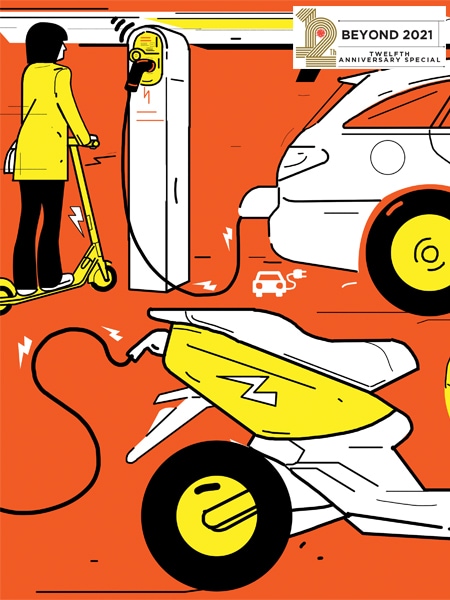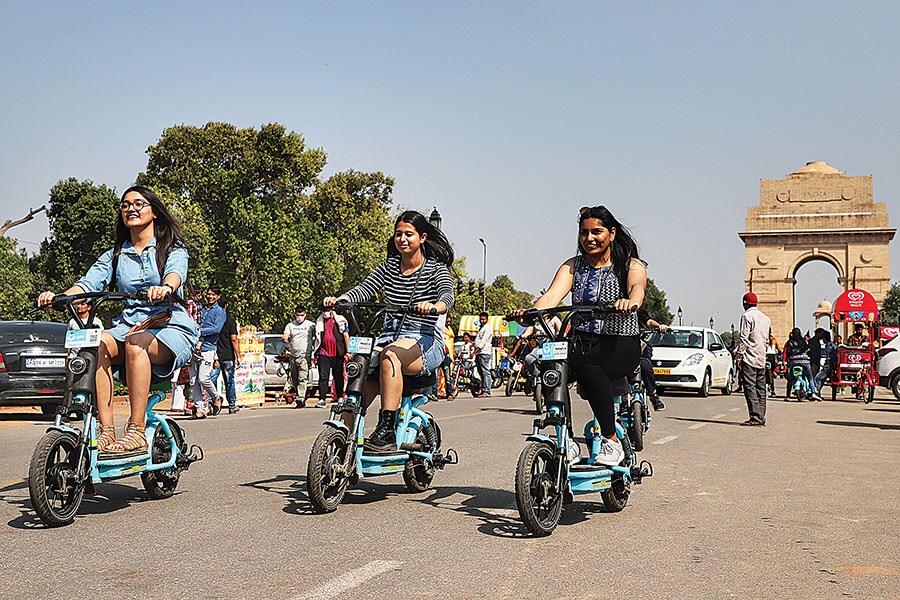One of the most fascinating advancements in new-age mobility is the influx of data and connectivity. Governments and private players around the world are collectively developing a robust and cohesive infrastructure to incorporate the data and features available on these vehicles to make mobility safer and more manageable. Over the next decade, we will see numerous improvements in managing the flow of vehicles thanks to data—like managing traffic violations, speed limits automatically enforced on vehicles with the ability to switch based on the roads you are travelling, fleet tracking to manage traffic jams across metropolitan areas during peak hours, and hopefully a steady decline in all accidents from fender benders to serious collisions.
While the world is getting ready to commercialise self-driving cars, India will take several more years to get there. The ecosystem and cost structures will first need to stabilise for autonomous vehicles to be a viable option in a price-sensitive market like India. Until then, we have electrification to look forward to.
Electrification in India will be led by light vehicles like two-wheelers and three-wheelers, and heavy vehicles like buses and trucks. As the price of electrification is fast approaching a tipping point and with the battery price expected to reach $100/kWh in the next three years, the unit economics of two-wheelers and three-wheelers is seeing a path to profitability in the short term. The four-wheeler market, on the other hand, will make the shift to EVs slowly mainly because the market size is low and unit economics will take time to stabilise.
The government of India is playing a key role in hastening the transition to electric. Fiscal incentives to encourage EV purchases from both central and state governments have led to an introduction of competitive replacements for current internal combustion engine (ICE) vehicles at an attractive price point. In addition to subsidising EV purchases and essential infrastructure development, the government has taken a keen interest in supporting the domestic design and manufacturing of EVs. This investment, coupled with India’s decades of experience in auto manufacturing, and a strong community of engineers will pay off strongly in the coming years.
![]() Electrification in India will be led by light vehicles like two-wheelers and three-wheelers, and heavy vehicles like buses and trucks
Electrification in India will be led by light vehicles like two-wheelers and three-wheelers, and heavy vehicles like buses and trucks
Image: Nasir Kachroo / Nur Photo via Getty Images
Today, even traditional automakers like Bajaj, TVS and Hero MotoCorp are heavily investing in EVs and speeding up product availability in the two-wheeler segment. Startups like Ather Energy and Ola Electric are investing in building a nationwide EV ecosystem, including supporting charging infrastructure. With more product offerings and charging platforms being available, India will continue to see significant growth in the private and shared ownership of electric two-wheelers. The government’s clear intent and traditional two-wheeler manufacturers’ investments have built the confidence of the supplier and ancillary ecosystem, as well as increased confidence among consumers. More suppliers today are willing to take a chance to work with EV makers—from prototyping to production.
The EV market could be valued at $206 billion in under 10 years. This will be powered by 80 percent of two-wheelers and three-wheelers going electric, followed by buses and commercial vehicles. And these 102 million EVs will need at least 2.9 million public chargers. In the short term, we can expect to see some “chaos" in charging infrastructure because of the lack of availability, accessibility and education around EVs and charging. India still doesn’t have any standardised connectors, though there are policies that cover the safety and utility of chargers. With more consumers buying personal EVs, there will be a surge in home charging, which means that Resident Welfare Associations, apartment societies, tech parks and housing complexes will begin to offer charging infrastructure. Indian end-consumers might also drive innovations by way of our famous “jugaad" system.
By 2030, a steep increase in electric two-wheeler sales, year on year, will have an incredible effect on the quality of ownership, ease of riding and quality of life. We will witness a drastic change on-roads, notably with the shift in heat and sound generated by all the vehicles. A 110 cc scooter engine typically generates 6 KW of heat, which is equivalent to the heat and power consumed by a centralised AC system for 1,500 to 2,000 sq ft of space. The average two-wheeler produces 80 decibels of sound today. With more EVs on roads, our environment and our daily commute will be noticeably more peaceful, limited just to the sound of electric.
undefinedAnalysts have moved from predicting 25% electric two-wheelers by 2030 to 25% by 2025 in the last six months[/bq]
On the product front, traditional ICE vehicles have limitations of design because the system requires standard form factors based on the power output requirement. Beyond the aesthetics of the body panel, lighting fixtures, etc, there is little else for industrial designers to work with. The wide variety of electric powertrains allows electric two-wheelers to have power variance ranging from 2 KW to 100 KW and each of these vehicles could have a unique form factor. This will allow customers to choose vehicles from across the spectrum, rather than from today’s limited power variance available, more than 100 cc, 110 cc, 125 cc, and so on.
EVs will be a key enabler in micro-mobility travel solutions like Yulu’s range of e-cycles and mopeds, all the way to Bird scooters and last-mile delivery solutions. There is a strong case to be made for the long-term profitability to use electric two-wheelers in the supply and distribution of both people and cargo. There are already several players like Go GreenBOV and Lithium that are offering electric alternatives for everything from last-mile delivery to employee transportation.
Two-wheelers aren’t the only electric revolution you can expect in the near future. Commercial vehicles are already going electric. Electrification in this segment, from today’s Tata Ace to 18-wheeler trucks, fits right into the business model and their scale allows for unit profitability, reduced running cost, and servicing cost plus the added benefit of charging infrastructure becoming more commonplace. Commercial vehicle electrification will lead to an increase in charging infrastructure not just within cities and on highways, but also in tier 2 and 3 towns and villages to support supply chain and distribution. The bulk of India’s energy production (with nearly 36 percent already coming from renewable sources) will be used for EVs, drastically reducing our reliance on fossil fuels. Over the next couple of years, expect charging infrastructure to be more readily available, which will improve customer awareness about EVs and push other original equipment manufacturers (OEMs), service providers and policymakers to support the transition.
The electric transition will be ably supported by the increase of connected vehicles. Today nearly all electric two-wheelers offer a certain degree of connectivity, either via an app or directly on the vehicle. According to a report, amid the Covid-19 crisis, the global connected vehicle market is estimated to reach a size of $251 billion between 2020 and 2027 with a CAGR of 16 percent. Connected vehicles will be the major driver for a new form of urban mobility that will provide actionable insights about vehicular and individual movement. Connected apps on these vehicles share data about road and traffic conditions to allow other connected vehicles to anticipate bottlenecks and improve traffic flow.
For example, being able to personalise vehicles could become a practice in the future. Connected scooters could use data to learn your favourite routes to shops, work, school or the gym, and thus be able to make personal decisions like what time is the most efficient to commute to work and how to make the best use of our time on the road. It will not only help people plan more efficiently but also provide information based on route planning to get vehicles to the closest refuelling and charging points, saving people a lot of time and expense.
These connected vehicles will profoundly change the ancillary industries. Insurance companies will use the data to assess the health of the vehicle and will have more data to assess the veracity of claims. Within OEMs, the data can open new business models and new ownership models for customers, after-sales can be done remotely and will be designed for each vehicle based on the health of the vehicle. Vehicle data will also help the second-hand sales industry by providing more quantitative and qualitative data to buyers and sellers, offering a more transparent pricing structure. Ather Energy also provides Ather Health Certificates to owners based on comprehensive data-based inspections on every aspect of the scooter—battery health, expected range, status of peripherals and so on. OEMs who are adopting the technology on their vehicle platforms can also work with policymakers for more integrated data across the ecosystem in terms of sales, ownership, charging infrastructure, and second life.
Financing models will see new additions like subscription-based ownership. There has been an upswing in private ownership in recent years, making it cost-effective while also allowing consumers to upgrade or change their vehicles easily, and will drive more sales. Usage models offered by both manufacturers and service providers will see more takers as EV product portfolios grow. There will be a larger market base looking for short-term ownership—from a few days to only three years, and these vehicles will find a second lease of life in the shared sector, if not in the second-hand market.
2030 is likely to see the complete transition to electric mobility. Market pundits, economists and consulting firms across the globe have been building models and predicting this revolution for over 20 years. EV predictions have consistently been getting more bullish and analysts have moved from predicting 25 percent electric two-wheelers by 2030 to 25 percent by 2025 in the last six months. And when one is at a true tipping point, by definition we are still underestimating the pace of change.
These predictions and models might not always be 100 percent accurate (none of them accounted for a global pandemic). But I can vouch for the fact that at least in mobility, the future might be here already.
â— The writer is co-founder & CEO, Ather Energy

 Illustration: Sameer Pawar
Illustration: Sameer Pawar
 Electrification in India will be led by light vehicles like two-wheelers and three-wheelers, and heavy vehicles like buses and trucks
Electrification in India will be led by light vehicles like two-wheelers and three-wheelers, and heavy vehicles like buses and trucks